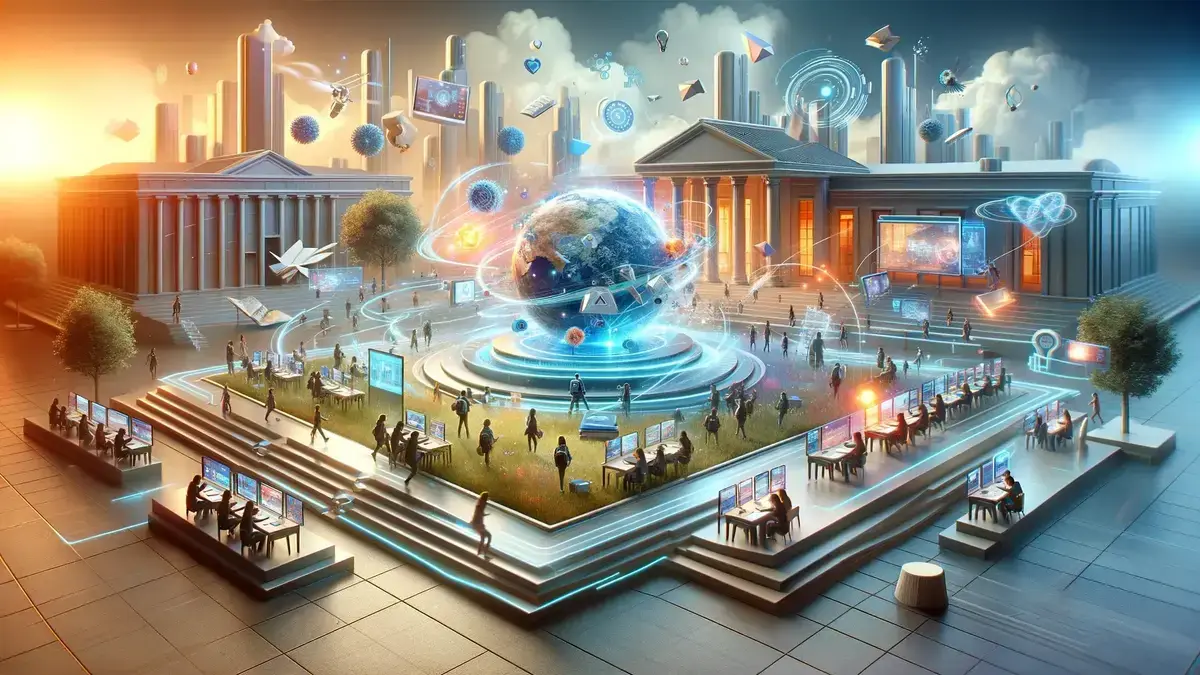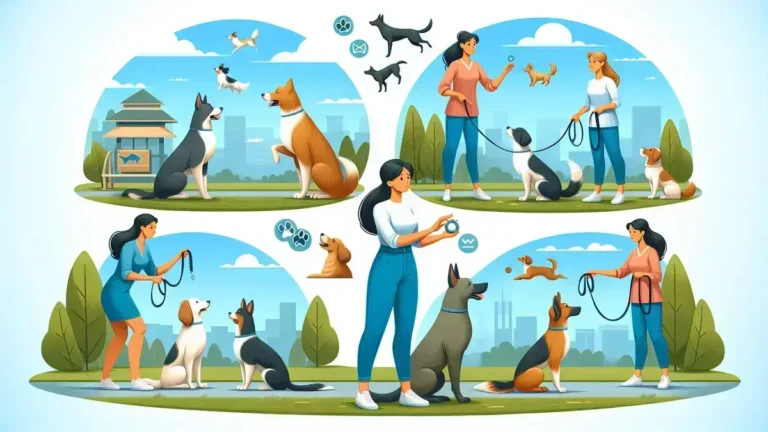Digital Learning Shapes Future Education
Digital learning is transforming the classroom, making waves by engaging students like never before. With the click of a button, learners can dive into a world where lessons are tailored to their unique needs and interests. Accessibility is key, breaking down the barriers to education and offering equal opportunities for all. This adaptable approach helps craft a personal educational journey, ensuring no two paths are alike, but every path is enriched with knowledge. As we tread into the future, digital learning doesn’t just teach subjects; it nurtures essential skills that will last a lifetime.
Key Takeaway
- Digital tools make learning fun.
- Online classes can be taken anywhere.
- Tech helps teachers grade work fast.
- Students learn at their own speed.
- Gadgets connect classmates worldwide.
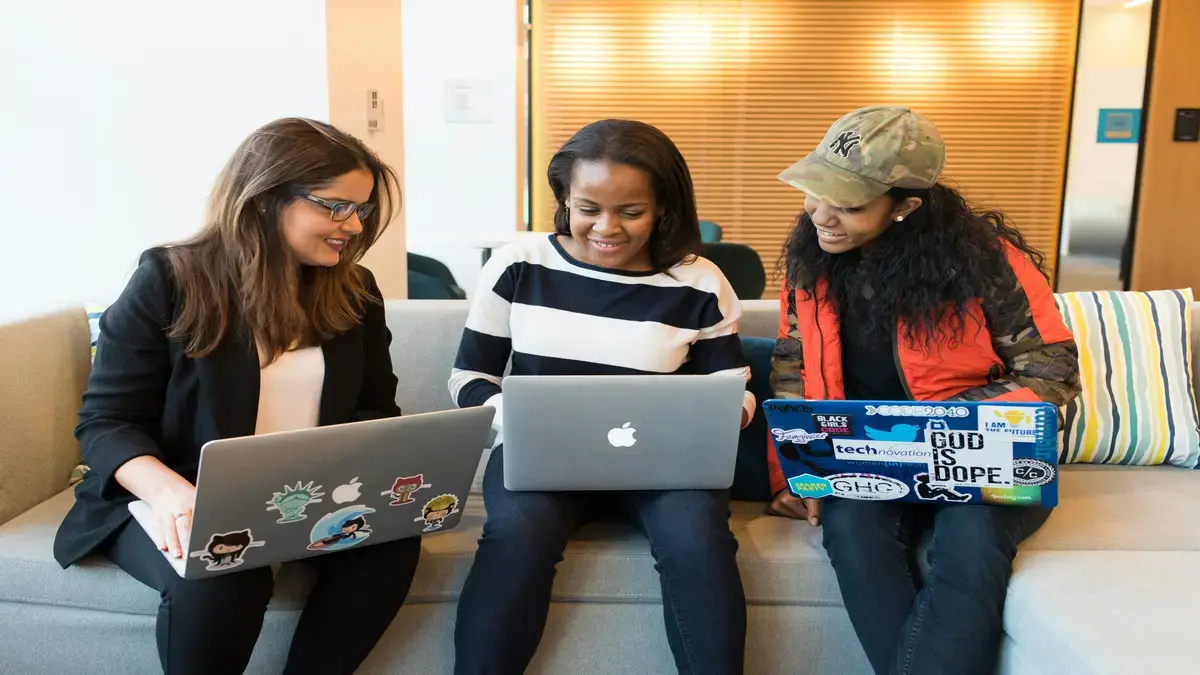
Embracing Digital Learning for Enhanced Student Engagement
Digital Learning is transforming the way students learn and how teachers teach. The integration of technology in education has opened doors to a myriad of interactive learning opportunities that can significantly increase student engagement. Let’s explore the various aspects of digital learning and its impact on education.
Interactive Learning Platforms
One of the most exciting developments in digital learning is the rise of interactive learning platforms. These platforms provide a space where students can engage with lessons in a dynamic way. For example, they can watch videos, play educational games, and take quizzes that provide instant feedback.
Benefits of Interactive Learning Platforms
- Students get to learn at their own pace.
- They receive immediate feedback, which helps them understand concepts better.
- Games and videos make learning fun and engaging.
Personalized Learning
With digital learning, teachers can offer personalized learning experiences. This means that lessons can be tailored to each student’s learning style and pace. Some students might need more time with math, while others might excel in reading. Digital tools help teachers track each student’s progress and provide the right support when needed.
How Personalized Learning Works
| Student Needs | Tools Used | Outcome |
|---|---|---|
| Extra help with math | Math apps and online tutorials | Better understanding of math concepts |
| Advanced reading | eBooks and reading apps | Improved reading skills |
| Visual learning | Infographics and videos | Enhanced retention of information |
Collaborative Projects
Collaboration is key in the modern classroom, and digital learning tools make it easier than ever. Students can work together on projects even when they’re not in the same room. They can share documents, give feedback, and create presentations all online.
Tools for Collaborative Projects
- Document sharing platforms like Google Docs.
- Presentation software such as PowerPoint Online.
- Project management tools to keep track of progress.
Flipped Classrooms
The flipped classroom is a teaching model that turns the traditional classroom on its head. In a flipped classroom, students watch lectures at home and do their ‘homework’ in class. This allows for more time to discuss topics in-depth and for teachers to help students one-on-one.
Flipped Classroom Approach
| At Home | In Class |
|---|---|
| Watch video lectures | Engage in discussions |
| Read materials | Work on practical exercises |
| Prepare questions | Receive personalized help |
Access to Global Resources
One of the best things about digital learning is that it gives students access to resources from all over the world. They can read articles from international news sources, watch documentaries, and even take virtual field trips to museums and historical sites.
Examples of Global Resources
- Online libraries with books from various countries.
- Virtual reality tours of the Louvre or the Great Wall of China.
- Live webinars with experts from different fields.
Enhanced Teacher-Student Communication
Communication between teachers and students is much easier with digital tools. Teachers can send messages, post announcements, and even hold video conferences with students. This helps keep everyone connected and informed.
Communication Tools for Teachers and Students
| Tool | Purpose |
|---|---|
| Email and messaging apps | Quick communication |
| Learning management systems | Share resources and assignments |
| Video conferencing software | Virtual meetings and classes |
Assessment and Feedback
Assessments are an important part of learning. Digital learning provides innovative ways to assess student understanding and give feedback. Students can take online quizzes that are automatically graded, allowing teachers to quickly see where students might be struggling.
Types of Digital Assessments
- Online quizzes with instant results.
- Interactive games that test knowledge.
- Peer assessments through online platforms.
Challenges and Considerations
While digital learning offers many benefits, there are also challenges to consider. Not all students have equal access to technology, and some may struggle with self-motivation in a digital environment. It’s important to find a balance and ensure that digital learning is inclusive for all students.
Addressing Digital Learning Challenges
| Challenge | Solution |
|---|---|
| Access to technology | School programs to lend devices |
| Internet connectivity | Community Wi-Fi initiatives |
| Motivation | Interactive and engaging content |
In my opinion, digital learning has the potential to revolutionize education. However, it’s crucial to address the digital divide and ensure that every student has the opportunity to benefit from these advancements. By embracing digital learning, educators can create a more engaging and personalized learning experience that prepares students for the future.

Bridging the Gap with Digital Learning Accessibility
Digital Learning has become a key part of education. But not everyone can use it the same way. Some students find it hard because they can’t see, hear, or move like other students. We need to make sure that everyone can learn with digital tools, no matter what.
Why Digital Learning Must Be for All
When we talk about education for everyone, we mean that every student should have the same chance to learn. Digital Learning can help with that. It can give students new ways to learn that fit their needs. But, if the digital tools are not made for all students, some will be left out. That’s not fair.
How to Make Digital Learning Work for Everyone
To make Digital Learning work for all, we need to think about a few things:
- Texts that can be heard: Some students need to hear the words, not just see them. So, digital tools should be able to read the text out loud.
- Subtitles and sign language: Videos should have words at the bottom for those who can’t hear well. And sometimes, using sign language in videos can help too.
- Easy to read and understand: The words we use should be simple. Big words can be hard for some students.
- Ways to control with voice or one hand: Some students can’t use a mouse or keyboard like others. They should be able to tell the computer what to do with their voice or use tools that need only one hand.
Real Stories of Students Who Need Better Digital Learning
Let’s talk about some students who face challenges:
| Student | Challenge | Needed Tool |
|---|---|---|
| Emma | Can’t see well | Screen reader |
| Liam | Hard to hear | Video subtitles |
| Olivia | Can’t use hands easily | Voice control |
These are just a few examples. There are many more students with different needs. We must think about all of them when we make Digital Learning tools.
What Schools Can Do to Help
Schools play a big part in making Digital Learning better for everyone. Here’s what they can do:
- Train teachers: Teachers should learn how to use digital tools that help all students.
- Choose the right tools: Schools should pick digital tools that are made for all kinds of students.
- Test the tools: Before using a new tool, schools should check if it works for students with different needs.
- Ask students: Schools should talk to students to find out what they need to learn better.
What Digital Learning Companies Should Do
Companies that make Digital Learning tools also have a job to do. They should:
- Build with everyone in mind: When making a new tool, think about all kinds of users from the start.
- Follow rules: There are rules about making digital tools work for everyone. Companies should follow these rules.
- Keep improving: They should keep making their tools better for all users.
How Parents Can Support Their Kids
Parents can help their kids use Digital Learning too. They can:
- Talk to teachers: Parents should tell teachers what their kids need to learn better.
- Find good tools: Look for digital tools that fit their child’s needs.
- Help at home: Make sure their child can use the digital tools they need at home.
Examples of Good Digital Learning Tools
There are some digital tools that are doing a great job. Here are a few:
| Tool | What It Does | Who It Helps |
|---|---|---|
| Read&Write | Reads text out loud | Students who need to hear words |
| Khan Academy | Has subtitles on videos | Students who can’t hear well |
| Google Voice Typing | Lets you control with voice | Students who can’t use hands easily |
What the Future Holds for Digital Learning
The future looks bright for Digital Learning. We’re seeing more tools that are made for all students. But there’s still work to do. We need to keep pushing for tools that everyone can use. It’s important because learning is for everyone.
My Opinion on Digital Learning Accessibility
In my opinion, making Digital Learning accessible is not just nice to have, it’s a must. It’s about giving every student a fair chance to learn. And when we do that, we make the world better for everyone.
How to Keep Learning About Digital Learning Accessibility
If you want to know more about making Digital Learning work for everyone, here are some ideas:
- Read books and articles: There are many books and articles about this topic. They can give you new ideas and help you understand more.
- Go to workshops: Sometimes, there are special classes where you can learn how to make digital tools better for all students.
- Join groups: There are groups of people who care about this topic. Being part of a group can help you learn and make a difference.
Remember, making Digital Learning accessible is about helping every student to learn in the best way for them. It’s a big job, but it’s worth it. Because when we help all students, we make the future brighter for everyone.

Personalizing the Journey with Digital Learning Adaptability
Digital Learning is changing the way students learn and teachers teach. It’s important because it lets students learn in a way that fits them best. This means they can learn at their own speed and in their own style.
What is Digital Learning?
Digital Learning is when we use computers, the internet, and technology to learn new things. It can be done at school, at home, or anywhere with an internet connection. It’s really helpful because it has lots of tools and ways to learn.
Why is Digital Learning Adaptability Important?
Every student is different. Some learn by reading, some by listening, and some by doing. Digital Learning lets teachers change the way they teach to help each student. This is super important because it can help all students do better in school.
Tools for Digital Learning
There are many tools for Digital Learning. Here are some:
- Videos: They are like TV shows that teach you things.
- Games: They make learning fun because they turn lessons into games.
- Quizzes: They help you remember what you learn by asking questions.
- Apps: They are like little helpers on your computer or tablet that teach you new things.
How Digital Learning Helps Different Students
Some students learn fast, and some learn slow. Digital Learning can be changed to help both. It can give extra help to those who need it and more challenges to those who learn fast.
| Student Type | How Digital Learning Helps |
|---|---|
| Fast Learners | They can learn more things and not get bored. |
| Slow Learners | They can take their time and get extra help. |
| Visual Learners | They can use videos and pictures to understand better. |
| Hands-on Learners | They can use games and activities to learn by doing. |
Teachers and Digital Learning
Teachers are super important in Digital Learning. They help make sure the technology is used in the best way. They also make sure that every student gets what they need to learn well.
Challenges Teachers Face with Digital Learning
Even though Digital Learning is great, it can be hard for teachers sometimes. They have to learn how to use new technology and find the best way to teach each student. But when they do, it can be really good for everyone.
Parents and Digital Learning
Parents are also a big part of Digital Learning. They can help their kids learn at home and make sure they are doing their best. They can also talk to teachers to understand how their kids are doing.
How Parents Can Support Digital Learning at Home
Parents can help by having a good place for their kids to learn at home. They can also make sure their kids have the tools they need, like a computer or tablet. And they can help their kids use the Digital Learning tools the right way.
Success Stories of Digital Learning
There are many stories of how Digital Learning has helped students. Some students who had trouble learning in a regular classroom did really well with Digital Learning. Others learned new things they never thought they could.
| Success Story | How Digital Learning Helped |
|---|---|
| Student A | Learned to read better with fun reading apps. |
| Student B | Got better at math with video lessons and quizzes. |
| Student C | Learned about science by doing experiments in a virtual lab. |
Future of Digital Learning
The future of Digital Learning looks really exciting. There will be more tools and ways to learn. Teachers and students will get even better at using technology to learn. It’s going to be important for everyone to keep learning how to use these new tools.
What Can We Expect in the Future?
We can expect to see more games, virtual reality, and maybe even robots in Digital Learning. This will make learning even more fun and helpful. We might also see students from all over the world learning together online.
It’s safe to say that Digital Learning is a big deal. It helps students learn in their own way and makes sure no one is left behind. It’s something that will keep getting better and will help us all learn more and more.
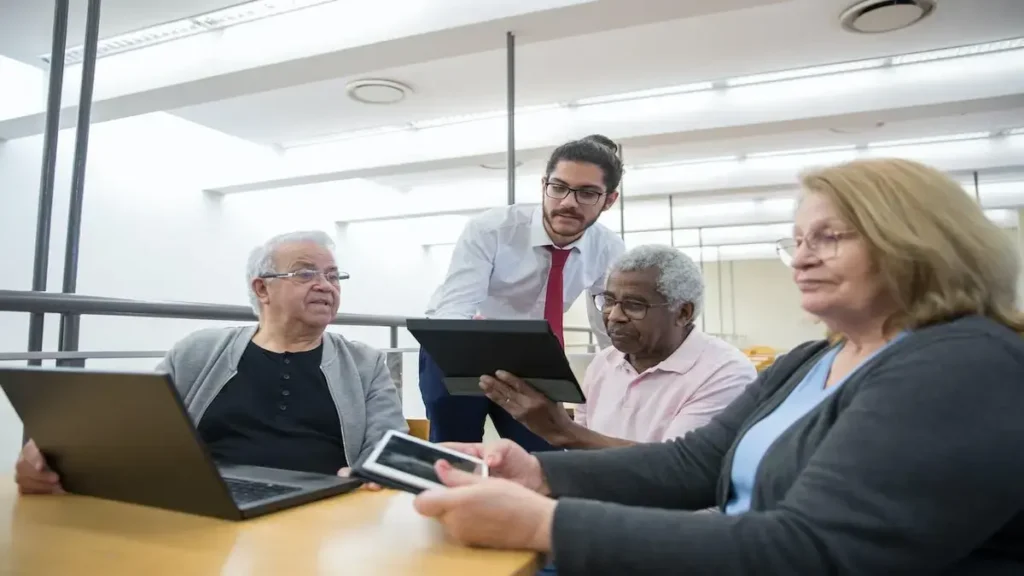
Fostering Lifelong Skills Through Digital Learning Initiatives
Digital Learning is not just about knowing how to use computers and software. It’s about how we can use technology to build skills that will help us for our whole lives. Let’s talk about some of the important skills we can get better at through Digital Learning.
Communication Skills
When we learn online, we use a lot of different ways to talk to each other. We might write emails, join video calls, or post in forums. This helps us get really good at sharing our ideas and listening to others.
Why Good Communication Matters:
- It helps us work well with other people.
- We can share our thoughts and understand others better.
- It’s important for almost every job you can think of.
Critical Thinking
With Digital Learning, we can find lots of information. But we need to think carefully about what is true and what is not. This is called critical thinking. It means asking questions and deciding what makes sense.
How Digital Learning Helps:
- We learn to check facts before we believe them.
- We get better at solving problems.
- We can make smart choices in school and in life.
Time Management
Learning online often means we have to plan our own time. We have to decide when to watch lessons, do homework, and study for tests. This is called time management, and it’s a very important skill.
Good Time Management Means:
- We can get our work done without feeling too rushed.
- We have time for fun and rest too.
- We are ready for jobs where we need to plan our day.
Technical Skills
Using technology for learning means we get better at using tools like computers, tablets, and software. These technical skills are very important today because almost every job uses some kind of technology.
Technical Skills Include:
- Knowing how to use different apps and programs.
- Understanding how to stay safe online.
- Being able to find information on the internet.
Teamwork
Sometimes, Digital Learning means working with other students online. This helps us practice teamwork. We learn how to share tasks, help each other, and reach a goal together.
Teamwork is Key Because:
- Many jobs need people who can work well in a team.
- It helps us understand how to work with people from different places.
- We learn how to listen and respect other people’s ideas.
Adaptability
Technology changes very fast. When we learn online, we often use new tools and ways of learning. This helps us get used to change. Being able to adapt is very important for all kinds of jobs and situations in life.
Being Adaptable Means:
- We can handle new challenges well.
- We are open to learning new things.
- We can work in many different kinds of jobs.
Self-Motivation
With Digital Learning, we often have to push ourselves to learn and do homework. This is called self-motivation. It’s a great skill because it means we can keep working hard, even when things are tough.
Self-Motivation Helps Us:
- Reach our goals.
- Keep going, even when we want to give up.
- Feel proud of what we can do.
Creativity
Online learning can be very creative. We might make videos, design websites, or write stories. These activities help our creativity grow. Being creative is great because it means we can think of new ideas and solve problems in cool ways.
Creativity is Important Because:
- It helps us see things differently.
- We can come up with new solutions to problems.
- It’s fun to make new things.
How Schools Are Using Digital Learning
Schools are doing lots of things to help students learn these skills. They give us computers and tablets to use. They also use programs that make learning fun and interesting.
Examples of Digital Learning in Schools:
| Activity | Skills It Helps | Why It’s Good |
|---|---|---|
| Online group projects | Teamwork, Communication | We learn to work with others. |
| Interactive games | Critical thinking, Creativity | We can solve problems in a fun way. |
| Video lessons | Technical skills, Adaptability | We get used to new ways of learning. |
| Time-management apps | Time Management, Self-Motivation | We learn to plan our own time. |
In my opinion, Digital Learning is a great way to help us get ready for the future. It makes learning fun and helps us get better at many different things. But it’s also important to remember that we need to balance our screen time with other activities like playing outside and talking with friends and family.
What Parents and Teachers Can Do
Parents and teachers play a big role in helping us learn these skills. They can choose good programs for us to use and help us when we have questions. They can also make sure we’re staying safe online.
Supporting Digital Learning:
- They can check in to see how we’re doing.
- They can help us find good information.
- They can encourage us to keep trying, even when it’s hard.
Remember, Digital Learning isn’t just about using technology. It’s about using technology to learn new things and get better at skills we’ll use all our lives. And that’s something that can help everyone, no matter how old they are or what they want to do in the future.
Frequently Asked Questions
- What is digital learning?
- Digital learning is when we use computers or the internet to learn new stuff. It’s like having a class on your screen!
- How does digital learning change schools?
- It makes learning super cool because you can study from anywhere and use fun videos and games to learn.
- Can digital learning help me with homework?
- Yep! You can find online help, videos, and quizzes to make homework easier and more fun.
- Do I need special stuff for digital learning?
- Just a computer or tablet and the internet. Sometimes you might need an app or program, but that’s all.
- Is digital learning as good as being in a real classroom?
- It’s different but still awesome. You can chat with teachers and friends online and learn in cool new ways.
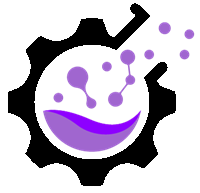
Este artigo foi criado pela nossa avançada ferramenta de criação de conteúdo. Quer produzir conteúdos de alta qualidade semelhantes sem esforço? Adquira nossa ferramenta hoje mesmo no Automatik Blog.

